Griffin, George Henry (Flying Officer)
Killed in Flying Accident 1954-July-09


Birth Date: 1924-February-20
Born: Lees, England
Parents: Son of George and Minnie (nee Currier) of Birmingham, England.
Spouse: Husband of Edna Beryl (nee Plummer) Griffin of Montreal, Quebec. Brother of Norman and Gordon Griffin.
Home: Lees, England
Enlistment: Montreal, Quebec
Enlistment Date: 1953-April-23
Service
RCAF
Unit
401 Sqn- Squadron
Mors Celerrima Hostibus Very swift death to the enemy
Base
Rank
Flying Officer
Position
Pilot
Service Numbers
105601
Home
Vampire serial: 17059
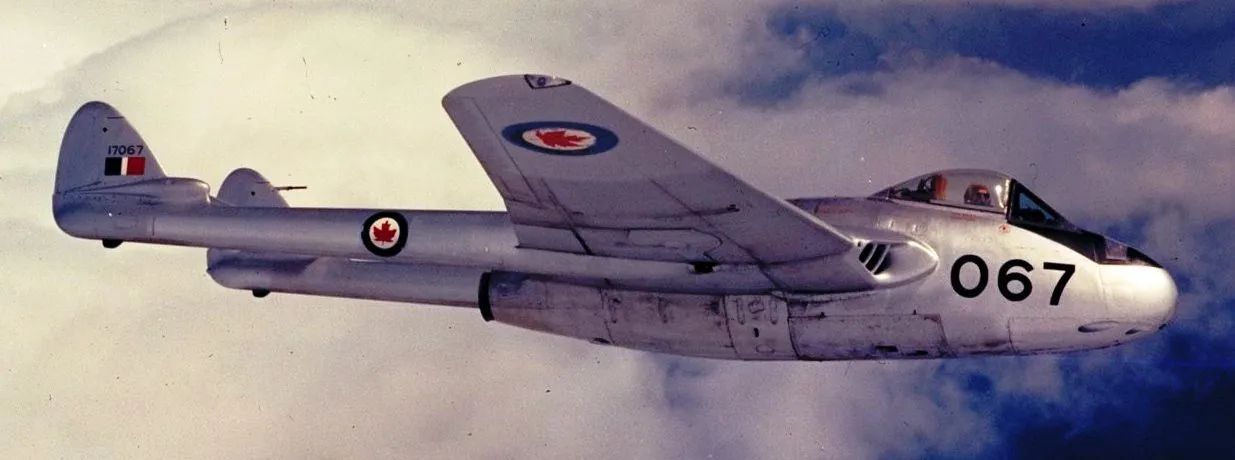
de Havilland DH.100 Vampire, RCAF (Serial No. 17067), No. 411 "County of York" Squadron (Auxiliary), Toronto, Ontario
The de Havilland Vampire is a British jet fighter which was developed and manufactured by the de Havilland Aircraft Company. It was the second jet fighter to be operated by the RAF, after the Gloster Meteor, and the first to be powered by a single jet engine.
Development of the Vampire as an experimental aircraft began in 1941 during the Second World War, to exploit the revolutionary innovation of jet propulsion. From the company's design studies, it was decided to use a single-engine, twin-boom aircraft, powered by the Halford H.1 turbojet (later produced as the "Goblin"). Aside from its propulsion system and twin-boom configuration, it was a relatively conventional aircraft. In May 1944 it was decided to produce the aircraft as an interceptor for the Royal Air Force (RAF). In 1946 the Vampire entered operational service with the RAF, only months after the war had ended.
The Vampire quickly proved to be effective and was adopted as a replacement of wartime piston-engined fighter aircraft. During its early service it accomplished several aviation firsts and achieved various records, such as being the first jet aircraft to cross the Atlantic Ocean. The Vampire remained in front-line RAF service until 1953 when it was progressively reassigned to various secondary roles, such as ground attack and pilot training, for which specialist variants were produced. The RAF retired the Vampire in 1966 when its final role of advanced trainer was filled by the Folland Gnat. The Royal Navy had also adapted the type as the Sea Vampire, a navalised variant suitable for operations from aircraft carriers. It was the service's first jet fighter.
The Vampire was exported to a wide variety of nations and was operated worldwide in numerous theatres and climates. Several countries deployed the type in combat during conflicts, including the Suez Crisis, the Malayan Emergency, and the Rhodesian Bush War. By the end of production, almost 3,300 Vampires had been manufactured, a quarter of these having been manufactured under licence in several other countries.
The layout of the DH.100 used a single jet engine installed in an egg-shaped fuselage which was primarily composed of plywood for the forward section and aluminium throughout the aft section. It was furnished with conventional mid-mounted straight wings; air brakes were installed on the wings to slow the aircraft, a feature that had also been incorporated in the Meteor. Armament comprised four 20 mm Hispano Mk V cannon located underneath the nose; from the onset of the design phase, even when the aircraft was officially intended to serve only as an experimental aircraft, the provision for the cannon armament had been included.
In 1946, a single Vampire F.1 began operating on an evaluation basis in Canada at the Winter Experimental Establishment in Edmonton. The Vampire F.3 was selected as one of two types of operational fighters for the Royal Canadian Air Force (RCAF) and was first flown in Canada on 17 January 1948 where it went into service as a Central Flying School training aircraft at RCAF Station Trenton. Operating a total of 86 aircraft, the Vampire F.3 became the first jet fighter to enter RCAF service in any significant numbers.
The Vampire had the function of introducing Canadian fighter pilots not only to jet propulsion, but also to other amenities such as cockpit pressurisation and the tricycle landing gear arrangement. It proved to be a popular aircraft, being easy to fly and often considered a "hot rod". In Canadian service, the Vampire served in both operational and air reserve units (400, 401, 402, 411, 438 and 442 squadrons). During the late 1950s, the type was retired and was replaced in RCAF service by the Canadair Sabre. Wikipedia
After retirement, 26 of the surplus RCAF Vampires were sold to the Formetal Division of Fliteways Inc., West Bend, Wisconsin, USA in 1958. Another 4 airframes were to provide spares. Aerial Blight Control, also of West Bend, refurbished 15 Vampires for sale to the Mexican Air Force starting in 1959. The FAM operated the Vampires until about 1970. Several of the remaining Vampires purchased by Fliteways found their way to the US civil market. Some may now be found in museums in Mexico, the U.S. or Canada.
Unit Desciption
401 Sqn Mors Celerrima Hostibus ("Ram")
History of the Squadron before and during World War II (Aircraft: Siskin III, Hurricane I, II, Spitfire Vb, IX, IXb)
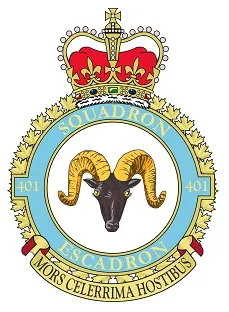
The roots of the squadron go back to No 81 (Canadian) Squadron RAF in 1918. This squadron was authorized as No 1 Squadron CAF around November 20 of that year, and was disbanded on January 28, 1920. It was re-formed at Jericho Beach (Vancouver), BC on 1 April 1925, and flew forestry and fishery patrols with Curtiss HS-2L flying boats, until it was transferred to the non-military Directorate of Civil Government Air Operationson 1 July 1927, and its service designation lapsed. The squadron was re-created at Trenton, ON in 1937 as No 1 (Fighter) Squadron RCAF. At the time it was equipped with Armstrong Whitworth Siskin III biplane fighters. It moved to Calgary in August 1938 and was re-equipped with Hawker Hurricane Mk 1 fighter aircraft in February 1939. On the outbreak of WWII in September 1939 the squadron was mobilized at St Hubert, QC, before moving to Dartmouth, NS in November. It absorbed No 115 (Fighter) Squadron of the Auxiliary in Montreal before moving to Britain in May 1940. After its aircraft had been modified to make them battle-fit at Middle Wallop, Hampshire and Croydon, Surrey, the squadron joined No 11 Group of RAF Fighter Command at Northolt, Middlesex, in August 1940, and saw action in the Battle of Britain, claiming 30 aircraft destroyed, 8 probably destroyed and 34 damaged. In October 1940 the squadron moved to bases in Scotland before moving briefly to No 12 Group Fighter Command in Driffield, Yorkshire. On March 1st, 1941 it was renumbered No 401 (Fighter) Squadron RCAF, at Digby, Lincolnshire, UK ![]() as part of the Canadian Digby Wing of 12 Group. The Squadron code letters were YO.
as part of the Canadian Digby Wing of 12 Group. The Squadron code letters were YO.
In October 1941 the squadron became again part of 11 Group, flying from several bases in Kent, ending up in September 1942 as part of the Canadian Kenley Wing until January 1943. In February 1941 the squadron converted to Hawker Hurricane Mk II aircraft, then in September of 1941 to Supermarine Spitfire Mk Vb. They flew different Marks of Spitfire for the rest of the war. During the period to early 1943, the squadron participated in fighter sweeps over France, and in RAMROD and RHUBARB operations. From January to May 1943 the squadron was rested at Catterick, Yorkshire and then it rejoined the Kenley Wing. In July 1943 Fighter Command was subsumed into the 2nd Tactical Air Force (TAF), and 401 Sqn was part of the No 126 (RCAF) Wing of No 83 Composite Group. Until June 1944 the squadron flew from Redhill, the Advanced Landing Ground at Staplehurst, Kent, Biggin Hill and Tangmere, Sussex where they continued fighter sweep and RAMROD operations. On and after D-Day the squadron patrolled the beachheads, and 12 days after D-Day the squadron moved to France, to No 4 Base at Beny-sur-Mer, Normandy. Thereafter until the cessation of hostilities the squadron’s Spitfires were employed in fighter and ground attack operations, moving from base to base through France, Belgium, the Netherlands and finally into Germany, as the armies moved northwards. The squadron was finally disbanded at Fassberg, Germany
![]() on 10 July 1945.
on 10 July 1945.
The squadron shot down 195 enemy aircraft, which made it the top-scoring squadron of the RCAF, and it was the leading squadron in the 2nd TAF with 112 air and 15 ground victories. It held the record for the most sorties flown (12,087). In October 1944 the unit recorded the first victory in the RAF/RCAF over a Me 262 jet fighter. Among the pilots there were 9 Aces (Squadron Leader W.T. Klersy DFC & Bar, Flight Lieutenant J. MacKay DFC & Bar, Flight Lieutenant D.R. Morrison DFC & DFM, Flying Officer G.D. Cameron DFC, Flying Officer J.P.W. Francis DFC, Flying Officer R.R. Bouskill, Flight Lieutenant G.W. Johnson DFC & Bar, Squadron Leader L.M. Cameron DFC, Flying Officer D.B. Dack). Several pilots also claimed triple victories in a single sortie. Aircrew operational losses were 61 pilots, of whom 6 were killed and 28 presumed dead. Aircrew were awarded 15 DFCs, 4 Bars to DFC and 1 DFM. Battle Honours were:Battle of Britain 1940, Defence of Britain 1940-44, English Channel and North Sea 1942, Fortress Europe 1941-44, Dieppe, France, Germany 1944-45Wikipedia, Kostenuk and Griffin
Maps for Movements of 401 Squadron 1940-45
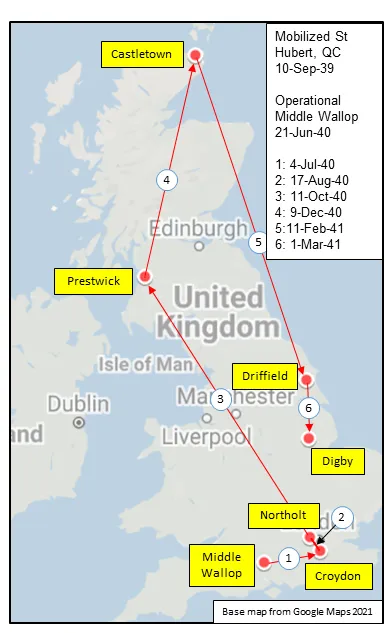
MAP 1: No 1 Squadron RCAF Movements 1940-41 (right-click on image to display enlarged view in new tab)
|
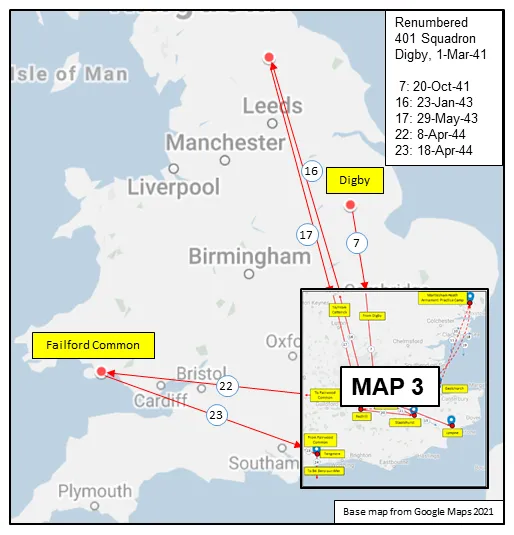
MAP 2: 401 Squadron Movements in UK 1941-44
|
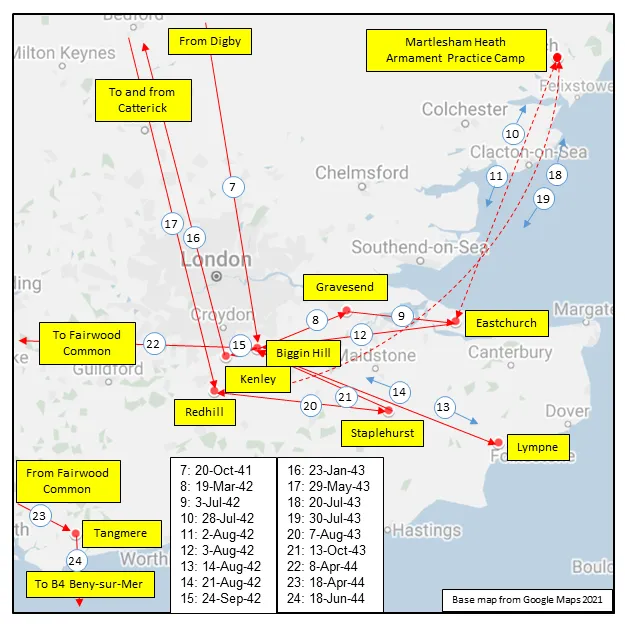
MAP 3: 401 Enlargement Detail of Map 2
|
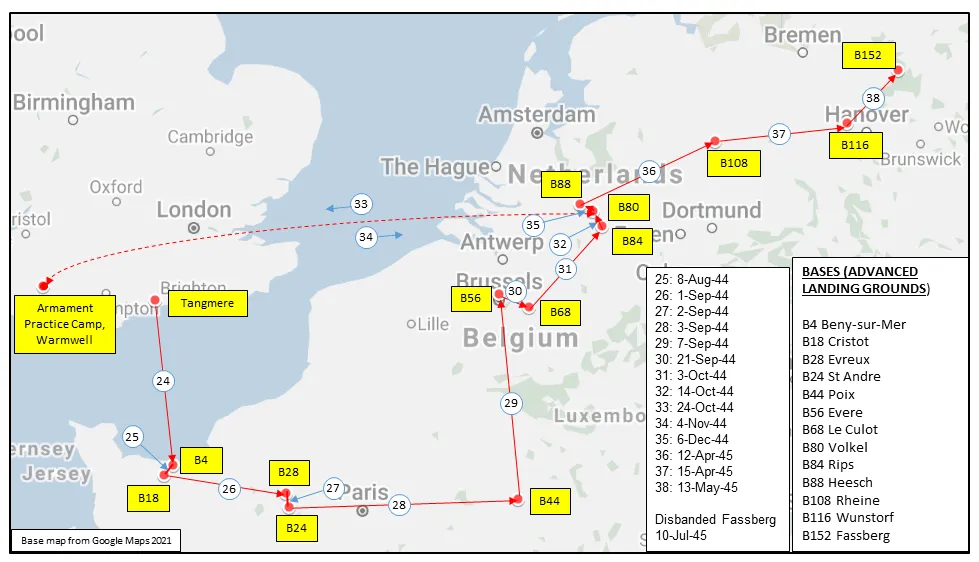
401 Squadron History Summary 1940-45
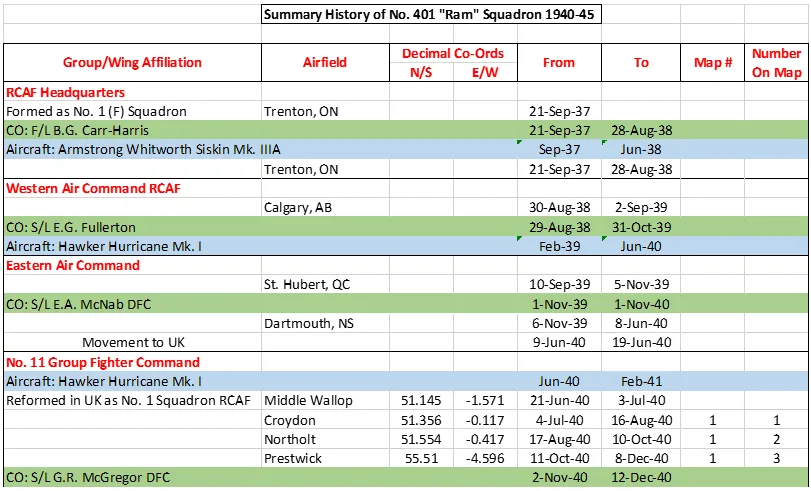
401 Squadron History Summary 1940-45 Page 2
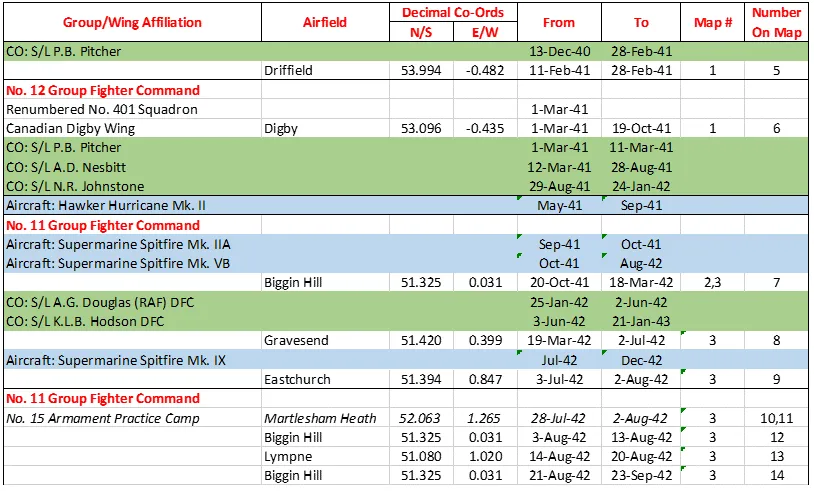
401 Squadron History Summary 1940-45 Page 3
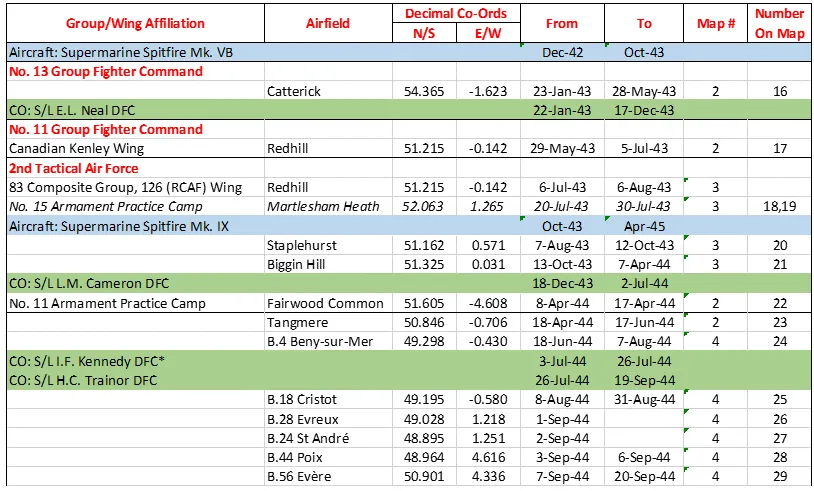
401 Squadron History Summary 1940-45 Page 4
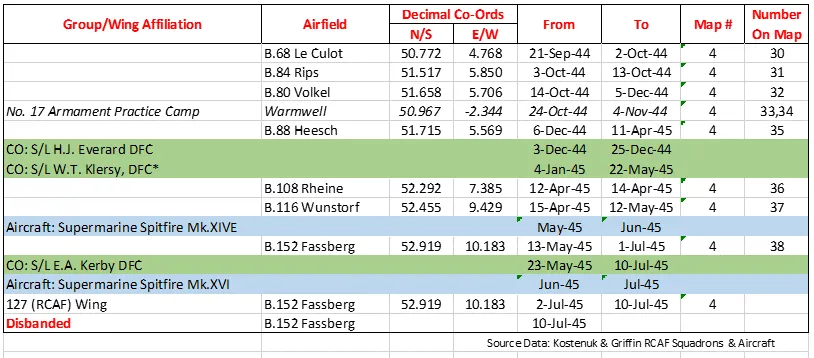
History of the Squadron Post-WWII (Aircraft: Vampire III, Sabre V, Expeditor, Otter, Kiowa, Hornet)
The squadron was reactivated as No 401 (F) Sqn (Aux) on 15 April 1946 at RCAF Station St. Hubert, Quebec ![]() . It was retitled ‘401 "City of Westmount" (F) Sqn (Aux)’ on September 4, 1952. The squadron flew de Havilland Vampire Mk. III and Canadair Sabre Mk. 5 aircraft in a fighter role until October 1958 when it was reassigned to a light transport and emergency rescue role, was re-designated '401 Squadron "City of Westmount" Sqn (Aux)' on November 1, 1958 and re-equipped with Beechcraft Expeditor and de Havilland Otter aircraft. The squadron was awarded a Squadron Standard on 5 May 1962. It was integrated into the Canadian Armed Forces as No 401 “City of Westmount†Air Reserve Squadron in January 1969. It was again re-designated '401 Helicopter Operational Training Squadron' on October 22, 1991. Flying the CH-136 Kiowa helicopter out of St. Hubert, Quebec. 401 Squadron was disbanded on June 23, 1996, after 55 years of operation.
. It was retitled ‘401 "City of Westmount" (F) Sqn (Aux)’ on September 4, 1952. The squadron flew de Havilland Vampire Mk. III and Canadair Sabre Mk. 5 aircraft in a fighter role until October 1958 when it was reassigned to a light transport and emergency rescue role, was re-designated '401 Squadron "City of Westmount" Sqn (Aux)' on November 1, 1958 and re-equipped with Beechcraft Expeditor and de Havilland Otter aircraft. The squadron was awarded a Squadron Standard on 5 May 1962. It was integrated into the Canadian Armed Forces as No 401 “City of Westmount†Air Reserve Squadron in January 1969. It was again re-designated '401 Helicopter Operational Training Squadron' on October 22, 1991. Flying the CH-136 Kiowa helicopter out of St. Hubert, Quebec. 401 Squadron was disbanded on June 23, 1996, after 55 years of operation.
The unit was reactivated as 401 Tactical Fighter Squadron on June 30, 2015, incorporating personnel from No 409 Tactical Fighter Squadron, flying the CF-18 Hornet aircraft. It celebrated its 100th Anniversary in 2018. Its first deployment was to Kuwait for offensive operations during Operation Impact, which is part of the Canadian Government’s approach to the Middle East. The reformed 401 Squadron complements the duties of 409 Tac F Sqn and, assisted by 410 Tactical Fighter (Operational Training) Squadron, deploys tactical fighter forces to meet Canadian and allied defence needs. It is based at Cold Lake, Alberta ![]() as part of RCAF 4 Wing. Under the umbrella of the NORAD mission, fighter crews are on stand-by 24/7 ready to respond to any aerospace threat.
as part of RCAF 4 Wing. Under the umbrella of the NORAD mission, fighter crews are on stand-by 24/7 ready to respond to any aerospace threat.